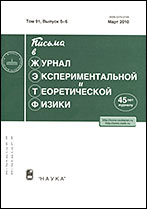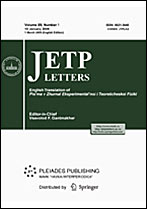|
This article is cited in 7 scientific papers (total in 7 papers)
OPTICS AND NUCLEAR PHYSICS
Melting of titanium by a shock wave generated by an intense femtosecond laser pulse
V. A. Khokhlova, V. V. Zhakhovskybc, N. A. Inogamovcba, S. I. Ashitkovb, D. S. Sitnikovbd, K. V. Khishchenkodebf, Yu. V. Petrovad, S. S. Manokhine, I. V. Nelasove, V. V. Shepelevg, Yu. R. Kolobove
a Landau Institute for Theoretical Physics, Russian Academy of Sciences, Chernogolovka, Moscow region, 142432 Russia
b Joint Institute for High Temperatures, Russian Academy of Sciences, Moscow, 125412 Russia
c All-Russia Research Institute of Automatics, Moscow, 127055 Russia
d Moscow Institute of Physics and Technology (National Research University), Dolgoprudnyi, Moscow region, 141701 Russia
e Institute of Problems of Chemical Physics, Russian Academy of Sciences, Chernogolovka, Moscow region, 142432 Russia
f National Research South Ural State University, Chelyabinsk, 454080 Russia
g Institute for Computer Aided Design, Russian Academy of Sciences, Moscow, 123056 Russia
Abstract:
Laser shock peening with ultrashort laser pulses has been studied by hydrodynamic and atomistic simulations, as well as experimentally. It has been shown that, in contrast to traditional nanosecond pulses, ultrashort laser pulses allow one to increase the produced pressures by two or three orders of magnitude from 1–10 GPa to 1000 GPa (1 TPa). The physics of phenomena changes fundamentally because shock waves generating pressures exceeding the bulk modulus of a metal melt it. It has been shown for the first time that the shock melting depth at pressures about 1 TPa is an order of magnitude larger than the thickness of the melt layer caused by heat conduction. The appearance, propagation, and damping of a melting shock wave in titanium have been studied. The damping of the shock wave makes it possible to modify the surface layer, where the melting regime changes from a fast one in the shock jump to a slow propagation of the melting front in the unloading tail behind the shock wave. It has been shown experimentally that the ultrafast crystallization of the melt forms a solid layer with a structure strongly different from that before the action. The measured depth of this layer is in good agreement with the calculation.
Received: 06.04.2022
Revised: 06.04.2022
Accepted: 07.04.2022
Citation:
V. A. Khokhlov, V. V. Zhakhovsky, N. A. Inogamov, S. I. Ashitkov, D. S. Sitnikov, K. V. Khishchenko, Yu. V. Petrov, S. S. Manokhin, I. V. Nelasov, V. V. Shepelev, Yu. R. Kolobov, “Melting of titanium by a shock wave generated by an intense femtosecond laser pulse”, Pis'ma v Zh. Èksper. Teoret. Fiz., 115:9 (2022), 576–584; JETP Letters, 115:9 (2022), 523–530
Linking options:
https://www.mathnet.ru/eng/jetpl6662 https://www.mathnet.ru/eng/jetpl/v115/i9/p576
|


| Statistics & downloads: |
| Abstract page: | 120 | | References: | 19 | | First page: | 17 |
|



 Contact us:
Contact us: Terms of Use
Terms of Use
 Registration to the website
Registration to the website Logotypes
Logotypes